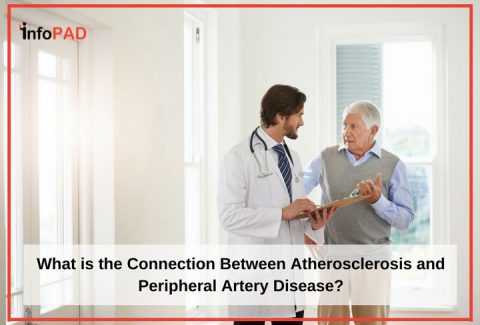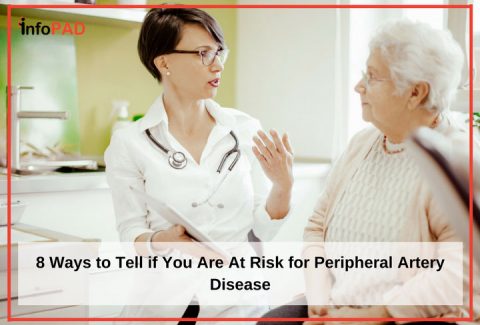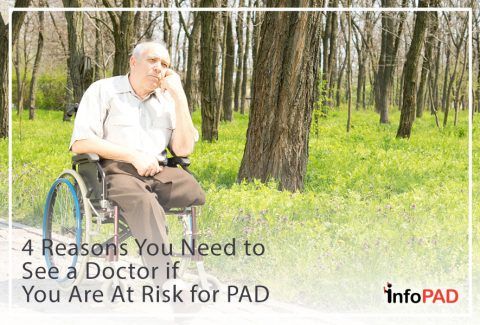
If you have just found out that you or a loved one is at an elevated risk for developing peripheral artery disease (PAD), there are several immediate steps you can take to greatly reduce your likelihood of developing the disease. Risk factors for PAD can include being over the age of 50 and having a history of diabetes or smoking, under age 50, but have diabetes and have high blood pressure or obesity.
If you have multiple PAD risk factors, your chance of developing the disease increases exponentially. Not taking immediate and aggressive action as soon as possible can lead to the development and progression of PAD. The longer you wait to address your risk factors, the greater the chance you have of needing invasive surgery. The most severe cases may result in loss of mobility or amputation. Extreme cases can even lead to death. To reduce your risk for PAD, focus on the following 5 things you can do – and take action!
What Can I Do if I Am At Risk for PAD?
1. Educate Yourself on the Signs and Symptoms of PAD
 Knowing what causes PAD is the first step in determining if you are at risk. PAD is caused by a narrowing or blockage of the blood vessels that restricts blood flow to the lower extremities. It is important to note that the symptoms of PAD are not uniform across age groups, genders, or races.
Knowing what causes PAD is the first step in determining if you are at risk. PAD is caused by a narrowing or blockage of the blood vessels that restricts blood flow to the lower extremities. It is important to note that the symptoms of PAD are not uniform across age groups, genders, or races.
- In some cases, the onset of peripheral artery disease begins with moderate discomfort or pain after or while walking.
- In other cases, it begins as numbness, or a discoloration of the lower limbs. If ignored over the long term, untreated peripheral artery disease can lead to severe pain, even at rest and non-healing ulcers on your legs or feet.
- In other cases still, PAD is completely asymptomatic (producing or showing no symptoms)
Still, often as PAD progresses and blood flow to the extremities is restricted, PAD can result in painful ulcers, sores which are slow to heal, or chronic infections in the ankle, feet, or toes.
RELATED: 7 Things You Must Be Aware of If Your PAD Goes Untreated
2. Make An Appointment With Your Physician to Discuss Your Concerns
Seek out a medical professional for advice on proactively reducing your risk for PAD before advanced symptoms appear or early symptoms have a chance to worsen. A primary care physician can either directly help, or can identify a PAD specialist known as an interventional radiologist in your area to discuss further concerns and:
- Accurately evaluate your current risk for developing PAD.
- Guide you in beginning a safe, effective exercise and nutrition program.
- Make sure you have thought of everything to reduce your personal risk.
- Find support groups for smoking cessation and healthier lifestyles.
- Ensure you are accountable at later appointments where they check your progress.
Ready to Speak with an Interventional Radiologist about Your PAD Symptoms? Make an Appointment Now
3. Get Moving
 Exercise has been shown to drastically decrease the risk of developing PAD.[i] In someone who is healthy enough to begin an unsupervised exercise program, professionals recommend attempting 5 to 10 minutes of brisk walking per day, with a goal of increasing to 20 minutes per day as an effective regimen to reduce PAD risk.[ii] Remember, if you are at risk of, or currently have, serious health issues, you should consult a physician before beginning a physical routine.
Exercise has been shown to drastically decrease the risk of developing PAD.[i] In someone who is healthy enough to begin an unsupervised exercise program, professionals recommend attempting 5 to 10 minutes of brisk walking per day, with a goal of increasing to 20 minutes per day as an effective regimen to reduce PAD risk.[ii] Remember, if you are at risk of, or currently have, serious health issues, you should consult a physician before beginning a physical routine.
4. Eat Healthier
Achieving an optimal and appropriate weight by eating healthy and cutting fats can drastically reduce your risk of developing peripheral artery disease. Excessive intake of food high in saturated fats, such as red meat, butter, and whole milk can raise your LDL – the “bad” cholesterol – levels, and cause buildup on the arterial walls. Replacing saturated fats with unsaturated fats is critical for curbing PAD risk.
5. Quit Smoking
If you are a smoker, quitting is the single most important thing that can be done to reduce the risk of developing peripheral artery disease.
- Smokers are four times more likely to develop PAD than those who don’t smoke.[iii]
- The nicotine in tobacco products causes restriction of blood vessels, which narrows arteries and creates an ideal environment for plaque to build up and cause a blockage.[iv]
- Multiple studies have shown that immediate smoking cessation dramatically decreases risk for developing PAD, and can even slow the progression of the disease after diagnosis.[v-ix]
These 5 strategies can be implemented immediately after discovering that you or a loved one is at risk for PAD. Proactively improving lifestyle habits, managing existing health complications, educating yourself and others about PAD symptoms, and seeking the guidance of a trusted primary care physician or vascular specialist can effectively slow the progression of peripheral artery disease or prevent it altogether.
Sources:
[i] http://www.ncbi.nlm.nih.gov.proxy.lib.mcw.edu/pubmed/?term=Exercise+interventions+and+peripheral+arterial+function%3A+implications+for+cardio-metabolic+disease
[ii] http://www.nhs.uk/Conditions/peripheralarterialdisease/Pages/Prevention.aspx
[iii] http://www.nhlbi.nih.gov/health/health-topics/topics/smo/risks
[iv] http://www.ncbi.nlm.nih.gov/pubmed/21144971
[v-ix] http://www.ncbi.nlm.nih.gov/pubmed/21646555



